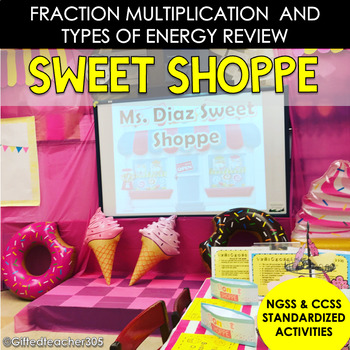Fraction Multiplication/Division and Types of Energy Review
- Zip
Also included in
- Get set and prepared for math and science labs and classroom transformations for the year with these high engagement math and science activities. These classroom transformations make learning math and science fun and meaningful. Mathematics and science activities become relevant as students practicPrice $194.60Original Price $278.00Save $83.40
Description
Do your students struggle with fraction multiplication and types of energy? Are you looking for a fun, interactive way to teach energy transfers and different models of fraction multiplication? This classroom transformation is sure to keep our students engaged and retaining the skills with real life problem-solving.
The Sweet Shoppe is an “EDITABLE” classroom transformation it is easy to put together and FUN! It consists of 5 game stations where students must complete an academic challenge before playing the game. It also aligned to science NGSS (Forms of Energy) standards and Common Core State Standard (CCSS) math activities (multiplication of fractions) : 5.NF.B.4a, 5.NF.B.5b,5.NF.B.4b,5.NF.B.6.
All solving real world problems involving multiplication of fractions and mixed numbers by using visual fraction models or equation.
What’s Included
ACTIVITIES
•Fraction Multiplication Recipe Problems
•Pie Pan Fraction Area Problems
•Hot Cocoa Mixed Fraction Multiplication
•Electricity & Static Electricity Problem Donuts
•Energy Ice Cream Cones
•Student Invites
•Class Banner
•Teacher Answer Key
GAMES
•Cupcake Sprinkle Toss
•Pie in the Face
•Donut Ring Toss
•Tic-Tac-Toes Ice Cream Cones
•Connect 4 Donuts
•Editable File
This transformation has 5 stations/challenges which may be done with or without the accompanying games. It can be done in one day as rotating station or expanded to be used over 4-5 days by using 1-2 games per day. You choose the option that best suits your needs.
If you like this classroom transformation you’ll love these!
The Nutcracker Classroom Transformation
Wizard Academy Classroom Theme
Pokémon Classroom Transformation
Basketball Interactive Ecosystems and Adaptatons Scavenger Hunt
Pokemon Inspired Unlock Bundle
Let’s connect and collaborate!






